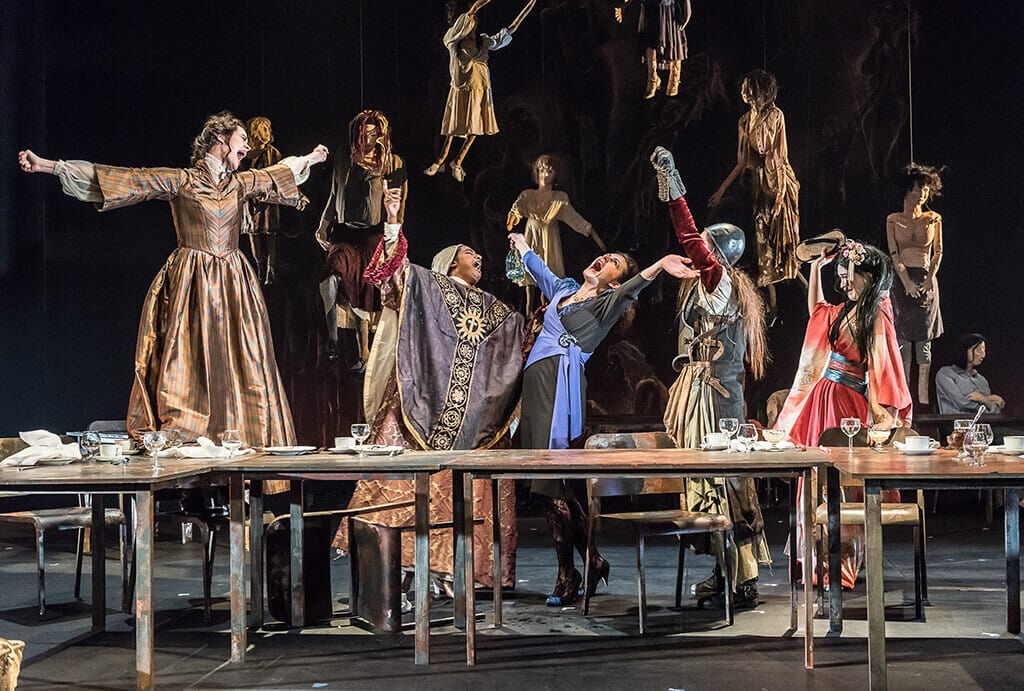The Guildhall School’s spring drama season continues with Caryl Churchill’s 1982 play Top Girls, a play which focuses on Marlene, a career-driven woman, who is only interested in the success of women in businesses. We watch Marlene through her success, through the success of her friends, and through a non-linear text, we find out just how much she has sacrificed to get where she is. We also discover all that she has left behind and secrets she has had to keep in order to conform to what being a successful woman in society is. Abigail Richardson, who plays Marlene, does this flawlessly and with ease; from the opening dinner scene, in which she is hosting a dinner party for a group of famous woman from history, to the last scene, in which we see her world become something else. Richardson’s ability to play within this world of money and power, ruthlessness and honour, and then go on to reflect on her past, shattering all that she has shown us just by gestures and ability to hold the audience, is commendable. The text itself is one that should be given credit. However, the cast’s ability to present the text in a professional manner almost comparable to the original at the Royal Courts is talent that should be recognised.
The set is not small. However, it is small enough to be altered and shifted in order to change location. The transitions between the acts are choreography in itself, with an all-female stage crew, dressed in black, close to secretarial attire or waitress uniform, appearing and seamlessly moving objects, and adding props. All this happens on a background scenery of hanging dolls that appeared like puppets of women, some with children, others pregnant, with a mixture of young and old. It is aesthetically pleasing. Also included on the background drawings are pastels of more women, naked, exposed, and vulnerable yet powerful. Dora Schweitzer really created a powerful playing ground for the actresses, shaped with an openness that invites the audience intellectually as well as supplying powerful and striking visuals during the play.
The play is famous for its dreamlike opening sequence, in which Marlene meets famous women from history, including Pope Joan, the explorer Isabella Bird; Lady Nijo. She also meets the Japanese mistress of an emperor, and later, a Buddhist nun, Dull Gret the Harrower of Hell; and Patient Griselda, the patient wife from The Clerk’s Tale in Geoffrey Chaucer’s Canterbury Tales. The opening scene is played with structured pace and overlapping conversations, which pull the audience in. The actresses all inhabit natural dinner party behaviour, increasingly getting drunk, and laughing flamboyantly. Their ability to reflect reality is something that added humour to the scene, making the audience comfortable yet uneasy as the characters reveal their suffering in similar ways, somewhat playing with the audience’s emotions.
Not only is this a strong ensemble piece, but also all actresses stood strong individually. Ellen Francis fantastically plays the character of Joyce, who was able to stand for the oppressed working class at that time. She is a believable character that moved and spoke to women of that time. As well as Rose D’Aulbey, whom I almost thought to be a child actor for a moment. D’Aulbey truly embodies childish characteristics, even in small moments; it is in the detail and concentration in vocal delivery and her presence on stage. Not forgetting the comedic characters that Angharad Bowen plays, starting with Dull Gret, who does not say much for the beginning of the first scene, but still manages to take the attention of the audience and the later one when she plays Nell. There is this one instance during the interview between Nell and Shona, which I thought she may have slipped out of character. However, it still worked, mainly due to this rawness that added to the intention – this harsh, dehumanisation women have to succumb to be successful in a Man’s world.
I also appreciate the use of real food and beverages on stage. It gives a satisfying feeling of realness and shows off the actresses’ ability to eat and project at the same time. Also the moments of silence and this awkward tension running throughout gives the audience time to swallow what the performers have put on our plates, and also adds beautifully to the production. Top Girls is truly a strong ensemble piece. It runs over two hours. However, it is not overwhelming, as the characters skillfully take their audience on this disjointed journey that changes the whole narrative and meaning in the end.

